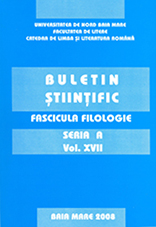Nume de persoană la românii din Banatul sârbesc central: perspectivă lingvistică şi culturală
Personal Names of the Romanians from Serbian Central Banat: Linguistic and Cultural Perspective
Author(s): Laura SpăriosuSubject(s): Language and Literature Studies
Published by: Editura U. T. Press
Keywords: Central Banat; onomastics; personal name; anthroponym; etymology;
Summary/Abstract: The research about personal names of the Romanians became a more and more intensive occupation of linguists at the beginning of the 20th century, but two attempts of a regional synthesis were published only in the fourth decade of that century; however, these attempts did not set the foundations for the hagiographic approach nor for the valid principles in onomastics. Almost all studies in the field of toponymy and anthroponymy in the Romanian professional literature investigate the concrete material from the area of onomastics which was collected from various old documents or directly, in the polls. In fact, one should mention that the number of professional works in this area is not large and that, when it comes to the Romanian language in the region of Vojvodina, a very small number of researches has been carried out. Having all that in mind, we decided to investigate personal names in the Romanian villages in the territory of Central Banat – Ečka, Jankov Most, Sutjeska, Torak, Uzdin. The material was collected from the registers of births and the analysis of all anthroponyms appearing in the period from 1900 to 2000 was carried out. The goal of the research was to establish which names were popular in the past, if they appear today and to which extent, which are the most popular names today, as well as to establish their origin. On the basis of the achieved results, we could conclude that from 1900 till the end of World War I - in addition to the traditional names encountered among the Romanian population in these regions (Ana, Floarea, Ion, Maria, Petru, Sofia, Todor, Vioara) - a series of Hungarian and German names was also used (András, Erzsébet, Ferenc, Ibolyka, István, János, Jóska, Sándor, Hans, Klaus). Due to the fact that after 1918 they were replaced with the names of other origin, Hungarian and German names slowly disappeared. In addition to the traditional names, which still persevereed, Slavic names appeared after 1920. Following the colonization implemented after 1945 (settlement of the population from Bosnia), these names saw real expansion. Finally, in the last decades of the 20th century, we were faced with the «invasion» of modern personal names from West Europe (Eduardo, Raul, Roberto). As for the origin of names, we noted the names of Latin, Greek, Slavic, Hebrew, German, Hungarian origin, the names specific for the Romanian onomastics, modern names from West Europe, local forms.
Journal: Buletin Stiintific, seria A, Fascicula Filologie
- Issue Year: XVII/2008
- Issue No: 1
- Page Range: 103-110
- Page Count: 8
- Language: Romanian

